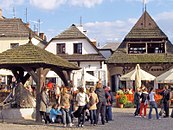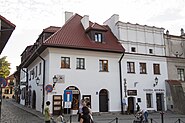Kazimierz Dolny
Kazimierz Dolny | ||
|---|---|---|
 Kazimierz Dolny - View of the town | ||
|
Car plates LPU | | |
| Website | kazimierzdolny.pl | |
Historic Monument of Poland | ||
| Designated | 1994-09-08 | |
| Reference no. | M.P. z 1994 r. Nr 50, poz. 417[1] | |
Kazimierz Dolny (Polish pronunciation: [kaˈʑimjɛʐ ˈdɔlnɨ]) is a small historic town in eastern Poland, on the right (eastern) bank of the Vistula river in Puławy County, Lublin Voivodeship. Historically it belongs to Lesser Poland, and in the past it was one of the most important cities of the province.
Now a tourist destination, the town enjoyed its greatest prosperity in the 16th and the first half of the 17th century, due to the trade in grain conducted along the Vistula. It became an economic backwater after that trade declined, and this freeze in economic development enabled the town to preserve its Renaissance urban plan and appearance. Since the 19th century it has become a holiday destination, attracting artists and summer residents.
Kazimierz Dolny is an art center in Poland. Many painters retreat to this small town to paint and sell their work. Galleries can be found in almost every street, offering for sale sculptures,
.The town is one of Poland's official national
Location
Kazimierz Dolny is located on the eastern bank of the Vistula (Wisła), at the edge of historical
History

The history of Kazimierz Dolny dates back to the 11th century, when on one of the local hills there was a Benedictine settlement called Wietrzna Gora. In 1181, Prince
The foundation of the town is attributed to Władysław's son, King Casimir III the Great, who granted the town rights in the first half of the 14th century. Later, King Władysław II Jagiełło modernized Kazimierz Dolny, creating a modern town, with a market square and streets. At that time, the decision was taken not to build any houses on the northern side of the market square, so as not to obstruct the view of the church and the castle.
In 1501, Kazimierz Dolny became the home of a starosta, and the town was passed over to the noble Firlej family, remaining in its hands until 1644. The Firlejs twice rebuilt the town and the castle, after the fires of 1561 and 1585. They cared about privileged status of Kazimierz Dolny, as a merchant town, located along the busy waterway of the Vistula. In 1628, Franciscan friars settled in Kazimierz, building a monastery and expanding the church.[5]
The town's golden age ended in February 1656 (see
From the late 19th century, more affluent residents of Lublin and Warsaw started to build properties in the area. Spas and villas were constructed, and in 1927, already in the Second Polish Republic, Kazimierz Dolny once again became a town. Partly destroyed in World War II, it was rebuilt, and on September 8, 1994, its center was officially recognized as a historical monument.[7]
Jewish life

A small
In the 19th century,
Between the First and Second World Wars, the Jewish population was about 1,400, half the total population of the town. The town's picturesque surroundings were chosen to film scenes for the
The Germans invaded Kazimierz Dolny in September 1939. The population at that time included about 1800 Jews, slightly less than 40 percent of the population. During the occupation, a
One of the most famous Jewish residents of the town was the painter and sculptor Chaim Goldberg. Another Jewish scion of the city was Polish-American journalist Samuel Leib Shneiderman.
Points of interest

Notable historical buildingslocated in Kazimierz Dolny include:[10][11]
- Parish church of St Bartholomew and John the Baptist (1586-1589), with 1620 organs, and 1615 pulpit,
- St Anne's Church (1671) and Holy Spirit hospital (1635),
- St Mary's Church (1589) and monastery (1638–68),
- Ruins of the castle (14th-16th century),
- Defensive tower (13th or 14th century),
- Several houses by the architect Karol Siciński, including one built by Kazimierz Ołdakowski
- Tenement houses (early 17th century),
- Several historic granaries (16th and 17th centuries).
- Synagogue.
Film and Art Festival
Kazimierz Dolny is also a place of a prominent Two Riversides Film and Art Festival ("Festiwal Filmu i Sztuki Dwa Brzegi") which is held every year during the month of August drawing many film lovers from around the world.[12] The town has been the location of several films.
Gallery
-
Market Square with Church of the Annunciation in the background
-
Historic well at the Market Square
-
Old Synagogue
-
St. Nicholas (left) and St. Christopher (right) townhouses
-
Celejowska townhouse
-
Senatorska street
-
Parish Church of St. John the Baptist
-
The Ulanowski Granary
-
Panorama of the town
-
Town centre
-
Vistula Riverin Kazimierz Dolny
Twin towns
Kazimierz Dolny is
 Szklarska Poręba (Poland)
Szklarska Poręba (Poland) Hortobágy (Hungary)
Hortobágy (Hungary) Staufen im Breisgau (Germany)
Staufen im Breisgau (Germany) Berlin-Steglitz (Germany)
Berlin-Steglitz (Germany) Pahiatua (New Zealand)
Pahiatua (New Zealand)
See also
References
- ^ Zarządzenie Prezydenta Rzeczypospolitej Polskiej z dnia 8 września 1994 r. w sprawie uznania za pomnik historii., M.P. z 1994 r. Nr 50, poz. 417
- ^ "Kazimierz Dolny". Retrieved 2019-09-13.
- ^ "The Big Break: Kazimierz Dolny". Retrieved 2019-09-16.
- ^ "Historia miejscowości". Retrieved 2019-09-13.
- ^ "Barokowy zespół klasztoru Reformatów (XVII w.)". polskaniezwykla.pl (in Polish). Retrieved 3 July 2023.
- ^ "Historia miejscowości". Retrieved 2019-09-13.
- ^ Anna Wieczorek. "Czy Kazimierz Dolny jest pomnikiem historii?" (PDF). bibliotekanauki.pl (in Polish). Retrieved 3 July 2023.
- ^ Faierstein, Morris M. "YIVO | Kuzmir-Modzits Hasidic Dynasty". www.yivoencyclopedia.org.
- ISBN 978-0-253-35599-7.
- ^ "The Best Things to See and Do in Kazimierz Dolny, Poland". Retrieved 2019-09-13.
- ^ "Kazimierz Dolny nad Wisłą - historia i zabytki". Retrieved 2019-09-13.
- ^ "KAZIMIERZ DOLNY: CREATIVITY RUNS DEEP IN THIS PART OF POLAND". Retrieved 13 September 2019.
- ^ "Miasta partnerskie". Retrieved 2019-09-13.
External links
- Information from About.com: Eastern Europe Travel Archived 2016-04-02 at the Wayback Machine
- Picture Archived 2011-10-07 at the Wayback Machine of the Holocaust memorial wall
- Pictures Archived 2008-08-21 at the Wayback Machine of the town from the site of Yad Vashem, the Jewish Holocaust memorial organization
- [1] Home page of the painter Chaim Goldberg, who was born in the village and who made its depiction during the period of 1930-1939 his life's mission. He painted from memory after that.
- https://kazimierzdolny24.pl/ Kazimierz Dolny events page













